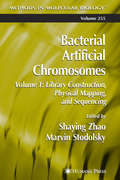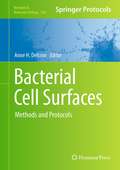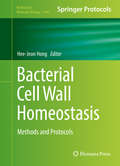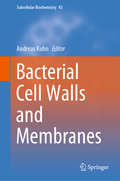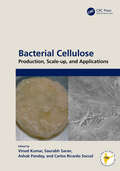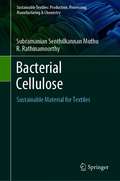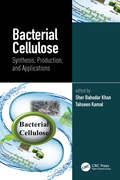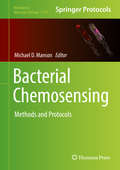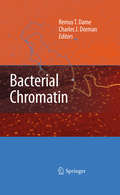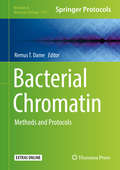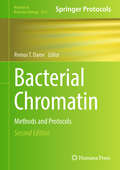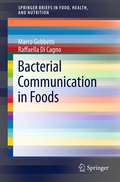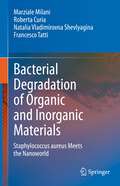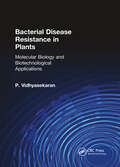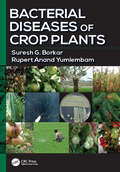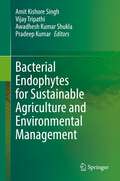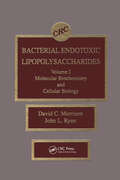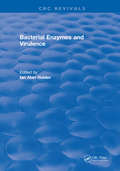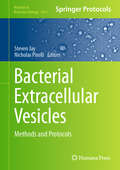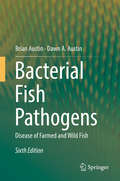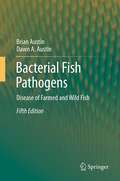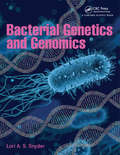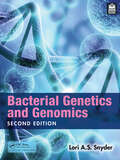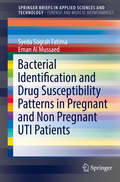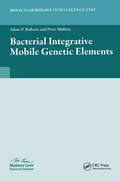- Table View
- List View
Bacterial Artificial Chromosomes: Volume 1: Library Construction, Physical Mapping, and Sequencing (Methods in Molecular Biology #255)
by Shaying Zhao Marvin StodolskyFor both volumes: Expert investigators describe not only the classic methods, but also the many novel techniques they have perfected for the transfer of large DNAs into the cells of both microbes and animals via large-insert recombinant DNAs. Volume 1 presents readily reproducible techniques for library construction, physical mapping, and sequencing.. An accompanying volume, Volume 2: Functional Studies, provides a wide variety of methods and applications for functional analysis of the DNA-transformed organisms. Besides protocols, each chapter includes scientific reviews, software tools, database resources, genome sequencing strategies, and illustrative case studies.
Bacterial Cell Surfaces: Methods and Protocols (Methods in Molecular Biology #966)
by Anne H. DelcourIn recent years, molecular microbiology has emerged as a top, cutting-edge biological discipline, thanks to the multi-disciplinary and integrative approaches taken by investigators seeking to understand the intricacies of the microbial world and how it affects human health and the biosphere. In Bacterial Cell Surfaces: Methods and Protocols, recent advances in structural biology, proteomics, and imaging techniques, together with the traditional biochemical and genetic approaches, are provided in order to present an exciting look into the structure, function, and regulation of the bacterial cell envelope. The detailed volume contains examples of traditional and innovative tools for the study of protein structure and function and enzymatic activities, the purification and analysis of macromolecules and their complexes, and the investigation of regulatory mechanisms and cell biological processes. Written in the highly successful Methods in Molecular BiologyTM series format, chapters include introductions to their respective topics, lists of the necessary materials and reagents, step-by-step, readily reproducible laboratory protocols, and tips on troubleshooting and avoiding known pitfalls. Authoritative and practical, Bacterial Cell Surfaces: Methods and Protocols is aimed at the microbiologist, biochemist, or cell biologist, whether a beginning graduate student or a veteran experimentalist, who wishes to learn new methodologies and take advantage of the years of research and protocol optimization from the best laboratories around the world.
Bacterial Cell Wall Homeostasis: Methods and Protocols (Methods in Molecular Biology #1440)
by Hee-Jeon HongThis volume brings together the most widely used and important protocols currently being employed in researching and understanding bacterial cell wall homeostasis. Chapters in "Bacterial Cell Wall Homeostasis" cover a variety of subjects, such as: modern microscopy techniques and other biophysical methods used to characterize the subcellular structure of the bacterial cell wall; high-throughput approaches that can be used to identify all the genes and proteins that participate in the correct functioning of an organism s cell wall; protocols for assaying individual gene products for specific cell wall functions or identify chemicals with inhibitory activity against the cell wall; and methods for analyzing the non-protein components of the cell wall and the increasing use of computational approaches for predicting and modeling cell wall related functions and processes. Written in the highly successful "Methods in Molecular Biology" series format, chapters include introduction to their respective topics, lists of the necessary material and reagents, step-by-step, readily reproducible laboratory protocols, and tips on troubleshooting and avoiding known pitfalls. Thorough and cutting-edge, "Bacterial Cell Wall Homeostasis: Methods and Protocols" emphasizes the diversity of the research taking place in bacterial cell wall homeostasis, and explains how the integration of information from across multiple disciplines is going to be essential if a holistic understanding of this important process is to be obtained. "
Bacterial Cell Walls and Membranes (Subcellular Biochemistry #92)
by Andreas KuhnThis book provides an up-to-date overview of the architecture and biosynthesis of bacterial and archaeal cell walls, highlighting the evolution-based similarities in, but also the intriguing differences between the cell walls of Gram-negative bacteria, the Firmicutes and Actinobacteria, and the Archaea. The recent major advances in this field, which have brought to light many new structural and functional details, are presented and discussed. Over the past five years, a number of novel systems, e.g. for lipid, porin and lipopolysaccharide biosynthesis have been described. In addition, new structural achievements with periplasmic chaperones have been made, all of which have revealed amazing details on how bacterial cell walls are synthesized. These findings provide an essential basis for future research, e.g. the development of new antibiotics. The book’s content is the logical continuation of Volume 84 of SCBI (on Prokaryotic Cytoskeletons), and sets the stage for upcoming volumes on Protein Complexes.
Bacterial Cellulose: Production, Scale-up, and Applications
by Vinod Kumar Carlos Ricardo Soccol Ashok Pandey Saurabh SaranThis reference book provides updated information on the production and industrial significance of bacterial cellulose. Bacterial cellulose is a natural fiber produced by certain microbes, mainly bacteria which belong to the Acetobacter genera. The book discusses its applications in different industrial sectors, such as food, pharmaceutical, energy, and wastewater treatment. It covers the production of cellulose from conventional and renewable feedstock and includes topics such as downstream processing, characterization, and chemical modification of bacterial cellulose. FEATURES Addresses the challenges of the production technologies of bacterial cellulose up to pilot scale Discusses cost-effective green processes using agri-processing residues and medium formulation Includes efficient preparation of nanocomposites using in vitro and in vivo methods Provides the latest applications of bacterial cellulose in the food and pharmaceuticals fields Reviews the production of bacterial cellulose from conventional feedstock such as sugars and starches This book is designed for industry experts and researchers of applied microbiology, bioprocesses, and industrial microbiology.
Bacterial Cellulose: Sustainable Material for Textiles (Sustainable Textiles: Production, Processing, Manufacturing & Chemistry)
by Subramanian Senthilkannan Muthu R. RathinamoorthyThis book presents the potential of bacterial cellulose in the textile and fashion industry. Most of the earlier work on the bacterial cellulose was focused on the bio technology application of cellulose, but the recent urge for the need of a sustainable material in the fashion and textile industries identified the scope of the bacterial cellulose in this aspect. The unique feature of this book is that it relates the bio technological aspects of bacterial cellulose with the sustainable issues in the fashion industry.
Bacterial Cellulose: Synthesis, Production, and Applications
by Sher Bahadar Khan Tahseen KamalBacterial cellulose (BC) is a natural polymer produced by different microbial cells. Its unique structural, physico-chemical, mechanical, thermal, and biological properties offer much potential for use in diverse applications in the biomedical, electronics, energy, and environmental fields, among others. This text provides an overview of the synthesis, characterization, modification, and application of BC. • Discusses sources, characterization, and biosynthesis of BC • Covers composites and aerogels based on BCs • Describes development of BCs from waste and challenges in large-scale production of BCs • Explores a variety of applications such as environmental, industrial, and biomedical This book will be of great interest to researchers and industry professionals in materials science, chemical engineering, chemistry, and other related fields seeking to learn about the synthesis and application of this important material.
Bacterial Chemosensing: Methods And Protocols (Methods In Molecular Biology #1729)
by Michael D. MansonThis volume covers a wide range of up-to-date technologies that have been successfully applied to study the chemosensing behavior of the traditional model species, such as Escherichia coli and Salmonella typhimurium, while being also applicable to a wide spectrum of other species. Beginning with an introduction, the sections of the book explore methods for studying bacterial chemotaxis at the population and whole-cell levels, in vivo analysis of receptor function, cryo-EM methods for studying chemoreceptor structure, as well as intracellular movement of chemosensory proteins, high-throughput methods to screen for novel chemoeffectors, and chemical tools and computer simulations for analyzing chemotaxis. Written for the highly successful Methods in Molecular Biology series, chapters include brief introductions to their topics, lists of the necessary materials and reagents, step-by-step, readily reproducible laboratory protocols, and tips for troubleshooting and avoiding known pitfalls. Authoritative and cutting-edge, Bacterial Chemosensing: Methods and Protocols provides an extensive repertoire of approaches that can be extended to understanding chemotaxis, in particular, and chemosensing, in general, in the context of the enormously varied lifestyles adopted in the larger bacterial world.
Bacterial Chromatin
by Charles J. Dorman Remus T. DameThe relative simplicity of the bacterial cell, short generation times and well defined and inexpensive culturing conditions have significantly contributed to our understanding of many complex biological systems. Yet the workings of the bacterial genome, seemingly impossibly compressed within a tiny nucleoid, have remained elusive. How is it that bacteria are able to package their genetic information within the confined space of the nucleoid while at the same time making it accessible for gene expression and DNA replication? This book, featuring the latest research by leading experts, describes the advanced methods being applied to the problem and shows how their work is contributing to our growing understanding of the ways that bacterial DNA storage, replication, recombination and gene expression are managed and coordinated. With due consideration paid to archaea and eukaryotes, the authors show how evolution in bacteria has provided solutions to these problems that range from the very sophisticated to the surprisingly simple. This comprehensive overview of bacterial chromatin clearly defines the fundamental concepts and goes on to show how cells inherit both chromosomal and extra-chromosomal genetic information at cell division. Several chapters are devoted to the central role played by nucleoid-associated proteins, with specific material on imaging the nucleoids, the physics of their structure and segregation, and the transcriptional regulation conducted by nucleoid-associated proteins. No other book currently available provides such a complete picture of these essential cellular processes.
Bacterial Chromatin: Methods and Protocols (Methods in Molecular Biology #1837)
by Remus T. DameThis volume brings together a wide range of methods to explore the structure and function of bacterial chromatin from molecular to the cellular scale. Chapters detail experimental protocols of in vivo and in vitro approaches, approaches to genome structure modeling, and data analysis. Written in the highly successful Methods in Molecular Biology series format, chapters include introductions to their respective topics, lists of the necessary materials and reagents, step-by-step, readily reproducible laboratory protocols, and tips on troubleshooting and avoiding known pitfalls.Authoritative and cutting-edge, Bacterial Chromatin: Methods and Protocols aims to be useful as an up-to-date reference work for scholars in the bacterial chromatin field, those entering the field from adjacent research fields, and scientists in the eukaryotic chromatin field.
Bacterial Chromatin: Methods and Protocols (Methods in Molecular Biology #2819)
by Remus T. DameThis second edition brings together new and updated methods to explore the structure and function of bacterial chromatin from molecular to the cellular scale. Chapters detail experimental protocols of in vivo and in vitro approaches, approaches to genome structure modeling, and data analysis. Written in the highly successful Methods in Molecular Biology series format, chapters include introductions to their respective topics, lists of the necessary materials and reagents, step-by-step, readily reproducible laboratory protocols, and key tips on troubleshooting and avoiding known pitfalls. Authoritative and cutting-edge, Bacterial Chromatin: Methods and Protocols, Second Edition aims to be a useful up-to-date reference work for researchers currently in the field and to those entering the field.
Bacterial Communication in Foods (SpringerBriefs in Food, Health, and Nutrition)
by Marco Gobbetti Raffaella Di CagnoIt is generally assumed that microorganisms synthesize, release, detect and respond to small signaling hormone-like molecules. These molecules are used for a process termed "quorum sensing" (QS), a phenomenon that enables bacteria to sense when the minimal number of cells, or "quorum," is achieved for a concerted response to be initiated. Words such as "language" and "behavior" are frequently used to depict QS in the literature. More simply put, language and cross-talk between bacteria, and between bacteria and animal or plant hosts, determines the behavior (e.g., beneficial or pathogenic effects) of bacteria. Currently, the major concern is to understand and decode this language. Overall, bacterial cross-talk was mainly studied on environmental, plant, and human pathogenic bacteria. Few studies considered food-related lactic acid bacteria. The cross-talk between bacteria influences the behavior and, in turn, the environmental adaptation and phenotypes. Therefore, it is understood that bacterial cross-talk has important applicative repercussions. The language spoken between bacteria populating the same food ecosystem may condition the phenotypic traits of starter lactic acid bacteria and, consequently, their performance. This Brief aims to define the basis of cell-to-cell signalling in food fermentation and will highlight: (i) microbiology, nutritional, chemical and functional aspects; (ii) functional properties due to microbial adaptation to the gastrointestinal tract; (iii) principal phenotypes under control of QS circuitries; (iv) quorum quenching. This Brief will be the first reference on this topic and it will highlight the main results for a more productive industrial application. Draft content 1. Signals of food related Gram-negative and Gram-positive bacteria The chapter will describe the different signaling languages used by Gram-negative bacteria (N-acyl-L-homoserine lactones) and Gram-positive bacteria (based on the synthesis of post-translationally modified peptides) and the universal chemical lexicon, shared by both Gram-positive and -negative bacteria (autoinducer-2 through the activity of the LuxS enzyme). 2. Phenotypes related to quorum sensing The chapter will describe the bacterial phenotypes, such as virulence, biofilm maturation, bacteriocin synthesis, and secondary metabolite production under control of QS circuitries. 3. Cell-to-cell signalling in fermented food: sourdough The chapter will describe the language spoken between bacteria populating the same food ecosystem (sourdough) and will provide an overview of the conditioned phenotypic traits of starter lactic acid bacteria and, consequently, their performance. 4. Cell-to-cell signalling in fermented food: yoghurt The chapter will describe the language spoken between bacteria populating the same food ecosystem (yoghurt) and will provide an overview of the conditioned phenotypic traits of starter lactic acid bacteria and, consequently, their performance. 5. Probiotic message at the intra-, inter-species and inter-kingdom level The chapter will describe the mechanisms that regulate the interaction between microorganism and host, and the capacity of the microorganism to adapt to environment. Particular reference will also be made to: (i) pathogen inhibition and restoration of microbial homeostasis through microbe-microbe interactions; (ii) enhancement of epithelial barrier function; and (iii) modulation of immune responses. 6. New Perspectives of quorum sensing This chapter will provide an overview of the future perspective regarding quorum sensing, showing that bacterial cross-talk may have important applicative repercussions. It will highlight the interference on the language of QS, which is defined as quorum quenching (QQ). Increasing translation of the bacterial cross-talk has shown that in some environmental circumstances, quenching of the language may occur.
Bacterial Degradation of Organic and Inorganic Materials: Staphylococcus aureus Meets the Nanoworld
by Marziale Milani Roberta Curia Natalia Vladimirovna Shevlyagina Francesco TattiThis interdisciplinary work deals with the bacterial degradation of organic and inorganic materials such as prosthetic devices and the consequent production of non-engineered nanoparticles (NPs). Focus is put on the interaction of these, often toxic, NPs with the environment, the microorganisms and the host human body. Electron Microscopy is the method of choice to investigate bacterial colonization and degradation of plastic polymers. Hence one section of the book is fully dedicated to the most recent and interesting microscopy technologies in microbiology and soft matters. The final chapter of the book on the complex and multivariate relationships between a microscopist and electron microscopy images is dedicated to Lyubov Vasilievna Didenko (1958 – 2015), a passionate researcher who contributed substantially to the field of Electron Microscopy research and its applications in studying bacterial-polymer interactions. The book addresses researchers and advanced students working in general and clinical microbiology, nanobiology, materials sciences and image analysis fields.
Bacterial Disease Resistance in Plants: Molecular Biology and Biotechnological Applications
by P. VidhyasekaranExamine the most recent developments in molecular plant pathology!This comprehensive reference book describes the molecular biology of plant-pathogen interactions in depth. With Dr. Vidhyasekaran’s keen insights and experienced critical viewpoint, Bacterial Disease Resistance in Plants: Molecular Biology and Biotechnological Applications not only presents reviews of current research but goes on to suggest future research strategies to exploit the studies in interventions with biotechnological, commercial, and field applications.This extraordinarily well-referenced book delivers in-depth examinations of: the molecular recognition process between plants and bacterial pathogens bacterial genes involved in the recognition process hrp, avr, dsp, and hsv genes the transcription of bacterial genes in plants signal transduction systems in bacteria and plants the functions of resistance genes and defense genes at the molecular level the elicitor molecules of bacterial pathogens and plants and their interactions plant and bacterial cell wall modifications and their role in triggering host defense mechanismsBacterial Disease Resistance in Plants also explores active oxygen species, inducible plant proteins and their signals and transcription mechanisms, inducible secondary metabolites, and more. It introduces novel strategies for bacterial disease management using genes from human beings, birds, crabs, insects, fungi, bacteria, and bacteriophages; and genetic engineering techniques that can be used to develop transgenic, disease-resistant plants. Generously illustrated with figures and tables that make the data more quickly understandable, Bacterial Disease Resistance in Plants will be an invaluable resource and textbook for plant pathologists, bacteriologists, botanists, plant physiologists, plant molecular biologists, microbiologists, biochemists, plant cell and applied biologists, genetic engineers, and graduate-level students in these disciplines.
Bacterial Diseases of Crop Plants
by Suresh G. Borkar Rupert Anand YumlembamFood and agriculture is an important component in the development and survival of civilizations. Around half of the world’s population and their economies are influenced by agricultural farm production. Plant diseases take as much as a 30 percent toll of the crop harvest if not managed properly and efficiently. Bacterial diseases of crop plants are important in plant disease scenarios worldwide and are observed on all kinds of cultivated and commercial value plants including cereals, pulses, oilseeds, fruits, vegetables, cash crops, plantation crops, spices, ornamentals and flowering plant, forage crop, forest trees, and lawn grasses. Bacterial diseases are widespread and are difficult to identify and to control. Few pesticides are available for use in control, and many plant pathologists are not well trained in the management of bacterial diseases. Bacterial Diseases of Crop Plants offers concise information on bacterial diseases of crops, proving a valuable asset to students, scientists in industry and academia, farmers, extension workers, and those who deal with crops that are vulnerable to bacterial diseases. The book contains 13 chapters featuring bacterial diseases of individual crops and is illustrated with full color photographs throughout providing amazing characterization of the diseases. It also includes information on bacterial diseases that appear on different crops across the continents, thereby making the content of interest to plant pathologists around the world. Bacterial diseases are of great economic concern, and their importance in overall losses caused by various other pathogens, such as fungi and viruses, is often undermined in developing countries.
Bacterial Endophytes for Sustainable Agriculture and Environmental Management
by Pradeep Kumar Vijay Tripathi Amit Kishore Singh Awadhesh Kumar ShuklaThis book is a comprehensive account of recent advances in the endophytic research. It covers recent perspective of endophytic research, molecular diversity, bioprospecting of novel genes using high throughput molecular techniques, and most importantly application of endophytes in practicing sustainable agriculture. Endophytic micro-organisms are mysterious living component associated mutually with plant roots and soil microbes. Various endophytic bacteria have attracted considerable attention for their ability to promote plant growth through direct mechanisms or by acting as biocontrol agents. Endophytes also find use in biocontrol, medicine, agriculture and food industry. This is a useful reading for the student of agriculture, environmental microbiology and biotechnology.
Bacterial Endotoxic Lipopolysaccharides
by David C. Morrison John L. RyanBacterial Endotoxic Lipopolysaccharides provides an up-to-date, two-volume review of the latest information regarding bacterial lipopolysaccharide structure and activities. These volumes cover the biochemistry, pharmacology, and pathophysiologic properties of endotoxins. The volumes also thoroughly discuss the strengths and weaknesses of new therapies for septic shock that are based on an immunological attack on endotoxins and the cytokines induced by endotoxins. All scientists involved in endotoxin research, clinical infectious disease specialists, and medical students interested in the pathogenesis of septic shock will find Bacterial Endotoxic Lipopolysaccharides invaluable as a reference resource.
Bacterial Enzymes and Virulence
by Ian Alan HolderAll aspects of the relationship between the elaboration of exoenzymes and the virulence of bacteria are addressed in the following pages. The authors have provided the most current information available in their areas of expertise. In circumstances where definitive information is lacking, the speculations of the authors should prove interesting to the reader.
Bacterial Extracellular Vesicles: Methods and Protocols (Methods in Molecular Biology #2843)
by Steven Jay Nicholas PirolliThis volume details procedures relevant to all disciplines, with specific emphasis on challenging aspects of working with Bacterial Extracellular Vesicle (BEVs). Chapters are divided into four parts focusing on characterization of Bacterial Extracellular Vesicles, assessment of Bacterial Extracellular Vesicle Biological Function In Vitro, preparation and functionalization of therapeutic Bacterial Extracellular Vesicles, and delivery and tracking of Bacterial Extracellular Vesicles In Vivo. Written in the highly successful Methods in Molecular Biology series format, chapters include introductions to their respective topics, lists of the necessary materials and reagents, step-by-step, readily reproducible laboratory protocols, and tips on troubleshooting and avoiding known pitfalls. Authoritative and cutting-edge, Bacterial Extracellular Vesicles: Methods and Protocols aims to ensure successful results in the further study of this vital field.
Bacterial Fish Pathogens: Disease of Farmed and Wild Fish (Springer Praxis Books / Aquaculture And Fisheries Ser.)
by Dawn A. Austin Brian AustinThis book puts emphasis on theisolation, taxonomy, diagnosis (phenotypic, serology and molecular biology),epizootiology, pathogenicity mechanisms, and methods of disease control (byvaccination, immunostimulation, probiotics, prebiotics, plant products, andantimicrobial compounds. Co-infections, which are attributed to more than onemicrobial species have been discussed. Shortcomings in knowledge have beenhighlighted. This sixth edition is the successor to the original version, first published in 1987, and which fillsthe need for an up-to-date comprehensive text on the biological aspects of thebacterial taxa which cause disease in finfish. Thebook is primarily targeted at researcher workers, including postgraduatestudents, and diagnosticians. It is anticipated that the readership willinclude veterinary microbiologists, public health scientists and microbialecologists.
Bacterial Fish Pathogens: Disease of Farmed and Wild Fish (Springer Praxis Books / Aquaculture And Fisheries Ser.)
by Dawn A. Austin Brian AustinThis completely updated fifth edition of Bacterial Fish Pathogens is a comprehensive discussion of the biological aspects of the bacteria which cause disease in farmed and wild fish. Since the 4th edition was published in 2007, there has been an upturn in the application of molecular approaches to taxonomy, diagnosis and vaccine development. New pathogens, e.g. Aeromonas schubertii, have been described. Also, there has been the emergence of diseases caused by bacteria which have not been cultured, and which have been equated with new taxa, i.e. 'Candidatus'. Consideration is given to all the bacterial fish pathogens, including primary pathogens and opportunists.
Bacterial Genetics and Genomics
by Lori A.S. SnyderOur understanding of bacterial genetics has progressed as the genomics field has advanced. Genetics and genomics complement and influence each other; they are inseparable. Under the novel insights from genetics and genomics, once-believed borders in biology start to fade: biological knowledge of the bacterial world is being viewed under a new light and concepts are being redefined. Species are difficult to delimit and relationships within and between groups of bacteria – the whole concept of a tree of life – is hotly debated when dealing with bacteria. The DNA within bacterial cells contains a variety of features and signals that influence the diversity of the microbial world. This text assumes readers have some knowledge of genetics and microbiology but acknowledges that it can be varied. Therefore, the book includes all of the information that readers need to know in order to understand the more advanced material in the book.
Bacterial Genetics and Genomics
by Lori A.S. Snyder Lori SnyderUnderstanding of bacterial genetics and genomics is fundamental to understanding bacteria and higher organisms, as well. Novel insights in the fields of genetics and genomics are challenging the once clear borders between the characteristics of bacteria and other life. Biological knowledge of the bacterial world is being viewed under a new light with input from genetic and genomics. Replication of bacterial circular and linear chromosomes, coupled (and uncoupled) transcription and translation, multiprotein systems that enhance survival, wide varieties of ways to control gene and protein expression, and a range of other features all influence the diversity of the microbial world. This text acknowledges that readers have varied knowledge of genetics and microbiology. Therefore, information is presented progressively, to enable all readers to understand the more advanced material in the book.This second edition of Bacterial Genetics and Genomics updates the information from the first edition with advances made over the past five years. This includes descriptions for 10 types of secretion systems, bacteria that can be seen with the naked eye, and differences between coupled transcription-translation and the uncoupled runaway transcription in bacteria. Topic updates include advances in bacteriophage therapy, biotechnology, and understanding bacterial evolution.Key Features Genetics, genomics, and bioinformatics integrated in one place Over 400 full-colour illustrations explain concepts and mechanisms throughout and are available to instructors for download A section dedicated to the application of genetics and genomics techniques, including a chapter devoted to laboratory techniques, which includes useful tips and recommendations for protocols, in addition to troubleshooting and alternative strategies Bulleted key points summarize each chapter Extensive self-study questions related to the chapter text and several discussion topics for study groups to explore further This book is extended and enhanced through a range of digital resources that include: Interactive online quizzes for each chapter Flashcards that allow the reader to test their understanding of key terms from the book Useful links for online resources associated with Chapters 16 and 17
Bacterial Identification and Drug Susceptibility Patterns in Pregnant and Non Pregnant UTI Patients (SpringerBriefs in Applied Sciences and Technology)
by Syeda Sograh Fatima Eman Al MussaedThis book provides a review of essential research on urinary tract infections (UTIs), as well as a broader perspective on methodologies adopted for the isolation and identification of the bacteria from urine samples of pregnant and non-pregnant women on the basis of their cultural, morphological and biochemical characteristics. The identification is extended to the strain level by means of molecular identification involving BLAST as a bioinformatics tool. The book also addresses the roles of various other bioinformatics tools for tracing the phylogenetic tree and conservation studies among the bacteriocin of the identified bacteria. Lastly, it assesses the antibiotics resistance patterns of these isolates.
Bacterial Integrative Mobile Genetic Elements (Molecular Biology Intelligence Unit Ser.)
by Peter Mullany Adam P. RobertsAs our understanding of mobile genetic elements continues to grow we are gaining a deeper appreciation of their importance in shaping the bacterial genome and in the properties they confer to their bacterial hosts. These include, but are by no means limited to, resistance to antibiotics, and heavy metals, toxin production and increased virulence, production of antibiotics and the ability to utilize a diverse range of metabolic substrates. We are also gaining an understanding of diversity of these elements and their interactions with each other; a property which continually complicates any attempt to classify them. We are learning more about the molecular mechanisms by which they translocate to new genomic sites both within genomes and between different bacteria. This book provides a timely, state of the art update on the properties of an important selection of different bacterial integrative mobile genetic elements and the myriad of different ways in which they move and influence the biology of the host bacterium. The chapters are all written by authors who have undertaken pioneering work in their respective fields, making this book vital reading for all who are interested in the biology of bacteria and the mobile elements they carry.
